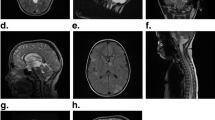Abstract
Purpose
To assess the role of high sensitivity next-generation sequencing (NGS) of CTNNB1 for the diagnosis of adamantinomatous craniopharyngiomas (aCPs) and of BRAF for that of papillary CPs (pCPs) in routinely processed surgical samples of nonadenomatous sellar lesions.
Methods
Forty-five cases of patients operated for nonadenomatous masses of the sellar region between 2004 and 2014 were retrieved from the files of the Anatomic Pathology unit of the Bellaria Hospital in Bologna, Italy. BRAF and CTNNB1 mutation status was analyzed by NGS in samples smaller than 1 cm3 and histological re-evaluation was performed on all cases.
Results
CTNNB1 mutation analysis showed a sensitivity of 86.7 % and a specificity of 96.2 % for the diagnosis of aCPs. The specificity increased to 100 % considering that in one case, initially classified as a non-CP lesion (xanthogranuloma), the identification of a CTNNB1 S47R lead to histological re-evaluation and reclassification of the lesion as aCP. BRAF mutation analysis had a sensitivity of 76.9 % and a specificity of 96.4 % for the diagnosis of pCPs. The specificity increased to 100 % considering that in one case, initially classified as a Rathke cyst, the identification of BRAF V600E lead to histological re-evaluation and reclassification of the lesion as pCP.
Conclusions
This study confirms the diagnostic relevance of the molecular alterations recently identified in aCPs and pCPs and shows how the identification of BRAF and CTNNB1 mutations can be instrumental for the proper classification of samples that contain limiting amounts of diagnostic lesional tissue.




Similar content being viewed by others

References
Louis DN, Ohgaki H, Wiestler OD, Cavenee WK (2007) World health organization classification of tumours of the central nervous system. IARC Press, Lyon
Bunin GR, Surawicz TS, Witman PA, Preston-Martin S, Davis F, Bruner JM (1998) The descriptive epidemiology of craniopharyngioma. J Neurosurg 89:547–551
Rodriguez FJ, Scheithauer BW, Tsunoda S, Kovacs K, Vidal S, Piepgras DG (2007) The spectrum of malignancy in craniopharyngioma. Am J Surg Pathol 31:1020–1028
Sofela AA, Hettige S, Curran O, Bassi S (2014) Malignant transformation in craniopharyngiomas. Neurosurgery 75:306–314
Cavallo LM, Frank G, Cappabianca P, Solari D, Mazzatenta D, Villa A, Zoli M, D’Enza AI, Esposito F, Pasquini E (2014) The endoscopic endonasal approach for the management of craniopharyngiomas: a series of 103 patients. J Neurosurg 121:100–113
Oikonomou E, Barreto DC, Soares B, De Marco L, Buchfelder M, Adams EF (2005) Beta-catenin mutations in craniopharyngiomas and pituitary adenomas. J Neurooncol 73:205–209
Sekine S, Shibata T, Kokubu A, Morishita Y, Noguchi M, Nakanishi Y, Sakamoto M, Hirohashi S (2002) Craniopharyngiomas of adamantinomatous type harbor beta-catenin gene mutations. Am J Pathol 161:1997–2001
Brastianos PK, Taylor-Weiner A, Manley PE, Jones RT, Dias-Santagata D, Thorner AR, Lawrence MS, Rodriguez FJ, Bernardo LA, Schubert L, Sunkavalli A, Shillingford N, Calicchio ML, Lidov HG, Taha H, Martinez-Lage M, Santi M, Storm PB, Lee JY, Palmer JN, Adappa ND, Scott RM, Dunn IF, Laws ER Jr, Stewart C, Ligon KL, Hoang MP, Van Hummelen P, Hahn WC, Louis DN, Resnick AC, Kieran MW, Getz G, Santagata S (2014) Exome sequencing identifies BRAF mutations in papillary craniopharyngiomas. Nat Genet 46:161–165
Marucci G, de Biase D, Visani M, Giulioni M, Martinoni M, Volpi L, Riguzzi P, Rubboli G, Michelucci R, Tallini G (2014) Mutant BRAF in low-grade epilepsy-associated tumors and focal cortical dysplasia. Ann Clin Transl Neurol 1:130–134
Rahmani R, Sukumaran M, Donaldson AM, Akselrod O, Lavi E, Schwartz TH (2015) Parasellar xanthogranulomas. J Neurosurg 122:812–817
Alomari AK, Kelley BJ, Damisah E, Marks A, Hui P, DiLuna M, Vortmeyer A (2015) Craniopharyngioma arising in a Rathke’s cleft cyst: case report. J Neurosurg Pediatr 15:250–254
Ogawa Y, Watanabe M, Tominaga T (2013) Rathke’s cleft cysts with significant squamous metaplasia–high risk of postoperative deterioration and close origins to craniopharyngioma. Acta Neurochir (Wien) 155:1069–1075
Buslei R, Nolde M, Hofmann B, Meissner S, Eyupoglu IY, Siebzehnrubl F, Hahnen E, Kreutzer J, Fahlbusch R (2005) Common mutations of beta-catenin in adamantinomatous craniopharyngiomas but not in other tumours originating from the sellar region. Acta Neuropathol 109:589–597
Hofmann BM, Kreutzer J, Saeger W, Buchfelder M, Blumcke I, Fahlbusch R, Buslei R (2006) Nuclear beta-catenin accumulation as reliable marker for the differentiation between cystic craniopharyngiomas and rathke cleft cysts: a clinico-pathologic approach. Am J Surg Pathol 30:1595–1603
Ihle MA, Fassunke J, Konig K, Grunewald I, Schlaak M, Kreuzberg N, Tietze L, Schildhaus HU, Buttner R, Merkelbach-Bruse S (2014) Comparison of high resolution melting analysis, pyrosequencing, next generation sequencing and immunohistochemistry to conventional Sanger sequencing for the detection of p. V600E and non-p.V600E BRAF mutations. BMC Cancer 14:13
Loes IM, Immervoll H, Angelsen JH, Horn A, Geisler J, Busch C, Lonning PE, Knappskog S (2015) Performance comparison of three BRAF V600E detection methods in malignant melanoma and colorectal cancer specimens. Tumour Biol 36:1003–1013
Jones RT, Abedalthagafi MS, Brahmandam M, Greenfield EA, Hoang MP, Louis DN, Hornick JL, Santagata S (2015) Cross-reactivity of the BRAF VE1 antibody with epitopes in axonemal dyneins leads to staining of cilia. Modern Pathol 28:596–606
Schweizer L, Capper D, Holsken A, Fahlbusch R, Flitsch J, Buchfelder M, Herold-Mende C, von Deimling A, Buslei R (2014) BRAF V600E analysis for the differentiation of papillary Craniopharyngiomas and Rathke’s Cleft Cysts. Neuropathol Appl Neurobiol. doi:10.1111/nan.12201
Kim JH, Paulus W, Heim S (2015) BRAF V600E mutation is a useful marker for differentiating Rathke’s cleft cyst with squamous metaplasia from papillary craniopharyngioma. J Neurooncol 123:189–191
Author information
Authors and Affiliations
Corresponding author
Ethics declarations
Conflict of interest
The authors declare that they have no conflict of interest.
Ethical standard
All procedures performed in studies involving human participants were in accordance with the ethical standards of the institutional and/or national research committee and with the 1964 Helsinki declaration and its later amendments or comparable ethical standards.
Rights and permissions
About this article
Cite this article
Marucci, G., de Biase, D., Zoli, M. et al. Targeted BRAF and CTNNB1 next-generation sequencing allows proper classification of nonadenomatous lesions of the sellar region in samples with limiting amounts of lesional cells. Pituitary 18, 905–911 (2015). https://doi.org/10.1007/s11102-015-0669-y
Published:
Issue Date:
DOI: https://doi.org/10.1007/s11102-015-0669-y



